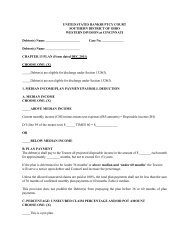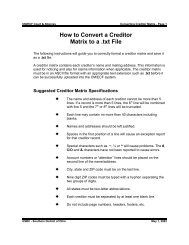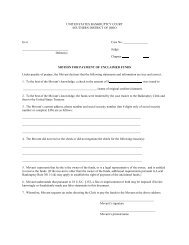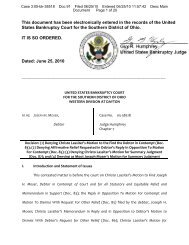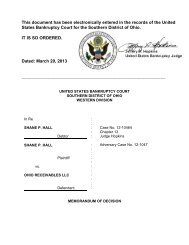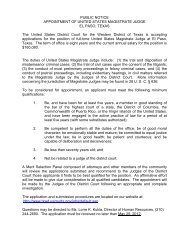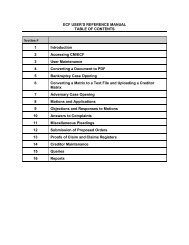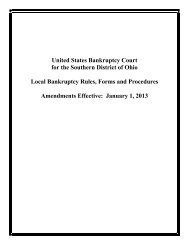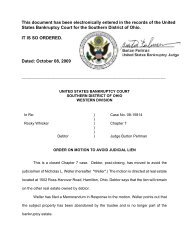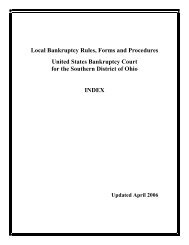This document has been electronically entered in the records of the ...
This document has been electronically entered in the records of the ...
This document has been electronically entered in the records of the ...
Create successful ePaper yourself
Turn your PDF publications into a flip-book with our unique Google optimized e-Paper software.
<strong>This</strong> <strong>document</strong> <strong>has</strong> <strong>been</strong> <strong>electronically</strong> <strong>entered</strong> <strong>in</strong> <strong>the</strong> <strong>records</strong> <strong>of</strong> <strong>the</strong> United<br />
States Bankruptcy Court for <strong>the</strong> Sou<strong>the</strong>rn District <strong>of</strong> Ohio.<br />
IT IS SO ORDERED.<br />
Dated: June 12, 2009<br />
____________________________________________________________<br />
UNITED STATES BANKRUPTCY COURT<br />
SOUTHERN DISTRICT OF OHIO<br />
WESTERN DIVISION<br />
In Re<br />
FRITZSCH CUSTOM<br />
BUILDERS, LLC<br />
Debtor<br />
:<br />
:<br />
:<br />
:<br />
:<br />
:<br />
Case No. 09-10083<br />
Chapter 11<br />
Judge Hopk<strong>in</strong>s<br />
MEMORANDUM OF DECISION<br />
ON ORDER CONVERTING CASE<br />
Thomas and Suzanne Nies, creditors <strong>of</strong> this estate, have filed <strong>the</strong> <strong>in</strong>stant<br />
motion ("Motion") (Doc. 22) seek<strong>in</strong>g to dismiss <strong>the</strong> chapter 11 case filed by <strong>the</strong><br />
Debtor, Fritzsch Custom Builders, LLC. The Motion is governed by 11 U.S.C. §<br />
1112(b)(1), which states that "<strong>the</strong> court shall convert a case under this chapter to a<br />
case under chapter 7 or dismiss a case under this chapter, whichever is <strong>in</strong> <strong>the</strong> best<br />
<strong>in</strong>terests <strong>of</strong> creditors and <strong>the</strong> estate, if <strong>the</strong> movant establishes cause." Under <strong>the</strong><br />
applicable law, dismissal is warranted if <strong>the</strong> movant <strong>has</strong> shown that "cause" exists<br />
and that, <strong>in</strong> <strong>the</strong> bankruptcy judge's op<strong>in</strong>ion, dismissal ra<strong>the</strong>r than conversion to<br />
chapter 7 is <strong>in</strong> <strong>the</strong> best <strong>in</strong>terest <strong>of</strong> creditors and <strong>the</strong> estate.
Case No. 09-10083<br />
FACTS<br />
The Debtor is a custom builder that possesses three assets: (1) a 2002 van with<br />
a scheduled value <strong>of</strong> $2,500; (2) a newly constructed custom home overlook<strong>in</strong>g <strong>the</strong><br />
Ohio River, appraised from $630,000 to $1,100,000 <strong>in</strong> its current condition; and (3)<br />
state law claims for monetary relief aga<strong>in</strong>st a surveyor and an <strong>in</strong>surance company.<br />
The Debtor concedes that it no longer operates an ongo<strong>in</strong>g construction bus<strong>in</strong>ess,<br />
does not generate any <strong>in</strong>come, and wants to use chapter 11 solely to liquidate <strong>the</strong><br />
assets <strong>of</strong> <strong>the</strong> estate ra<strong>the</strong>r than reorganize.<br />
I. 3025 Ononta and <strong>the</strong> View Easement<br />
The chapter 11 case was precipitated by a divisive and protracted lawsuit <strong>in</strong><br />
state court aris<strong>in</strong>g from <strong>the</strong> construction <strong>of</strong> <strong>the</strong> Debtor's custom home, located at<br />
3025 Ononta Avenue, C<strong>in</strong>c<strong>in</strong>nati, Ohio. Mr. and Mrs. Nies own <strong>the</strong> home next<br />
door. 3025 Ononta is subject to a view easement that benefits <strong>the</strong> Nies property.<br />
The easement prohibits <strong>the</strong> owner <strong>of</strong> 3025 Ononta from occupy<strong>in</strong>g certa<strong>in</strong> airspace<br />
above <strong>the</strong> property so that <strong>the</strong> owner <strong>of</strong> <strong>the</strong> property where <strong>the</strong> Nieses currently<br />
reside may enjoy an unobstructed view <strong>of</strong> <strong>the</strong> Ohio River. When <strong>the</strong> Debtor built<br />
3025 Ononta, it <strong>in</strong>advertently encroached upon <strong>the</strong> Nieses' property's easement.<br />
II. State Court Litigation<br />
The issue was litigated extensively <strong>in</strong> state court. An appeal <strong>has</strong> <strong>been</strong> lodged<br />
by <strong>the</strong> Debtor from an adverse decision rendered aga<strong>in</strong>st it. 1 There are three<br />
pr<strong>in</strong>cipal components to <strong>the</strong> state court proceed<strong>in</strong>gs.<br />
A. Vertical Encroachment<br />
One <strong>of</strong> <strong>the</strong> issues was whe<strong>the</strong>r <strong>the</strong> easement applied only to airspace above<br />
631.30 feet over sea level. If so, <strong>the</strong>n two decks attached to <strong>the</strong> home below 631.30<br />
would not have violated <strong>the</strong> easement. The trial court concluded that <strong>the</strong> easement<br />
1 The Debtor also filed a motion, pursuant to 11 U.S.C. § 362(d), seek<strong>in</strong>g to<br />
modify <strong>the</strong> automatic stay (Doc. 39) so that <strong>the</strong> Debtor can pursue an appeal <strong>in</strong><br />
state court. Thomas Nies filed a response (Doc. 46) to <strong>the</strong> motion. By separate<br />
order <strong>entered</strong> <strong>in</strong> this case, <strong>the</strong> motion to modify <strong>the</strong> stay will be granted.<br />
2
Case No. 09-10083<br />
did not have a 631.30 floor, as argued by <strong>the</strong> Debtor, and ordered removal <strong>of</strong> <strong>the</strong><br />
decks and <strong>the</strong>ir footers. The decks and footers are no longer part <strong>of</strong> <strong>the</strong> home.<br />
B. Horizontal Encroachment<br />
Follow<strong>in</strong>g <strong>the</strong> trial court's legal determ<strong>in</strong>ation concern<strong>in</strong>g <strong>the</strong> vertical<br />
parameters <strong>of</strong> <strong>the</strong> easement, a jury awarded damages to <strong>the</strong> Nieses for a horizontal<br />
encroachment <strong>of</strong> approximately 3.5 feet. The Debtor does not dispute <strong>the</strong> horizontal<br />
encroachment or <strong>the</strong> amount <strong>of</strong> <strong>the</strong> jury award for $166,000 owed <strong>the</strong> Nieses.<br />
C. Attorney's Fees<br />
Lastly, <strong>the</strong> trial court ordered <strong>the</strong> Debtor to pay for <strong>the</strong> Nieses' attorney's<br />
fees, be<strong>in</strong>g approximately $92,000.<br />
III. Chapter 11 Strategy – Maximize Value Through Litigation<br />
The Debtor concedes that this is a liquidat<strong>in</strong>g chapter 11. Accord<strong>in</strong>g to <strong>the</strong><br />
Debtor, its strongest motivation for fil<strong>in</strong>g this case is to maximize <strong>the</strong> dividend to<br />
unsecured trade creditors it <strong>has</strong> done bus<strong>in</strong>ess with over <strong>the</strong> years. Of concern,<br />
however, is that <strong>the</strong> Debtor <strong>in</strong>tends to accomplish this through litigation, ra<strong>the</strong>r than<br />
a reorganized home build<strong>in</strong>g bus<strong>in</strong>ess with restructured debt, a revamped bus<strong>in</strong>ess<br />
plan and perhaps some new <strong>in</strong>vestors. Specifically, <strong>the</strong> Debtor wants to pursue four<br />
lawsuits to fund a chapter 11 plan. Until <strong>the</strong> Debtor prevails <strong>in</strong> <strong>the</strong>se various pieces<br />
<strong>of</strong> litigation, <strong>the</strong>re is no o<strong>the</strong>r money available to keep <strong>the</strong> Debtor afloat o<strong>the</strong>r than<br />
<strong>the</strong> payments Robert Fritzsch, <strong>the</strong> Debtor's pr<strong>in</strong>cipal, is mak<strong>in</strong>g on <strong>the</strong> quarterly<br />
U.S. Trustee fees and utilities at 3025 Ononta.<br />
A. Appeal <strong>of</strong> State Court Decision<br />
First, and foremost, <strong>the</strong> Debtor <strong>has</strong> appealed <strong>the</strong> state court decision<br />
concern<strong>in</strong>g: (1) <strong>the</strong> f<strong>in</strong>d<strong>in</strong>g <strong>of</strong> vertical encroachment; and (2) <strong>the</strong> award <strong>of</strong> attorney's<br />
fees. If <strong>the</strong> state appellate court determ<strong>in</strong>es that <strong>the</strong> easement does not extend below<br />
631.30 over sea level, <strong>the</strong> Debtor believes that <strong>the</strong> value <strong>of</strong> <strong>the</strong> property will be<br />
greatly enhanced because: (1) <strong>the</strong> decks would be re<strong>in</strong>stalled; and (2) <strong>the</strong> owner<br />
3
Case No. 09-10083<br />
would possess unrestricted use and enjoyment <strong>of</strong> <strong>the</strong> yard. 2 In addition, if <strong>the</strong><br />
appeals court reverses <strong>the</strong> attorney's fees award, <strong>the</strong> secured claims aga<strong>in</strong>st <strong>the</strong> estate<br />
will be reduced by $92,000.<br />
B. Action Aga<strong>in</strong>st Surveyor<br />
The Debtor would also like to <strong>in</strong>itiate a state court action aga<strong>in</strong>st <strong>the</strong><br />
pr<strong>of</strong>essional it hired to survey 3025 Ononta. The Debtor believes that <strong>the</strong> surveyor<br />
should have discovered a second easement recorded <strong>in</strong> 1991 from public <strong>records</strong> and<br />
notified <strong>the</strong> Debtor <strong>of</strong> it before construction began. Based on <strong>the</strong> surveyor's alleged<br />
negligence, <strong>the</strong> Debtor contends that it will recover monetary damages for $166,000,<br />
<strong>the</strong> amount <strong>the</strong> jury awarded to <strong>the</strong> Nieses for <strong>the</strong> horizontal encroachment.<br />
Accord<strong>in</strong>g to <strong>the</strong> Debtor, once <strong>the</strong>se funds are recovered <strong>the</strong>y will become property<br />
<strong>of</strong> <strong>the</strong> estate and used to repay creditors. The Debtor is, at best, uncerta<strong>in</strong> how long<br />
<strong>the</strong> litigation might take, and <strong>the</strong>re is no guarantee that <strong>the</strong> Debtor will prevail.<br />
C. Action Aga<strong>in</strong>st Insurer<br />
The Debtor also <strong>in</strong>tends to file a state court action aga<strong>in</strong>st its own <strong>in</strong>surance<br />
carrier. The action would seek coverage for: (1) <strong>the</strong> encroachment <strong>of</strong> <strong>the</strong> horizontal<br />
and vertical easements; and (2) <strong>the</strong> attorney's fees <strong>the</strong> Debtor <strong>in</strong>curred <strong>in</strong> defend<strong>in</strong>g<br />
<strong>the</strong> Nies action <strong>in</strong> <strong>the</strong> trial court. The Debtor <strong>has</strong> identified an attorney who is<br />
will<strong>in</strong>g to pursue this action on a cont<strong>in</strong>gent fee, perhaps m<strong>in</strong>imiz<strong>in</strong>g <strong>the</strong><br />
adm<strong>in</strong>istrative costs to <strong>the</strong> estate. If <strong>the</strong> Debtor prevails <strong>in</strong> <strong>the</strong> litigation it once aga<strong>in</strong><br />
hopes to <strong>in</strong>crease <strong>the</strong> dividend that <strong>the</strong> estate will pay unsecured creditors. At a<br />
m<strong>in</strong>imum, $146,313.60 or <strong>the</strong> amount <strong>the</strong> Debtor owes on <strong>the</strong> attorneys fees<br />
<strong>in</strong>curred to defend aga<strong>in</strong>st <strong>the</strong> Nies lawsuit could be recovered from <strong>the</strong> <strong>in</strong>surer.<br />
Aga<strong>in</strong>, <strong>the</strong> Court is left to wonder about <strong>the</strong> duration <strong>of</strong> <strong>the</strong> litigation and whe<strong>the</strong>r<br />
<strong>the</strong> Debtor will ultimately succeed.<br />
D. Action to Avoid Nies Judgment Lien<br />
Subsequent to <strong>the</strong>ir state court judgment, <strong>the</strong> Nieses obta<strong>in</strong>ed a judgment lien<br />
2 Given <strong>the</strong> state trial court's construction <strong>of</strong> <strong>the</strong> easement, <strong>the</strong> Debtor contends that<br />
<strong>the</strong> owner <strong>of</strong> 3025 Ononta cannot plant flowers or place a lawn chair <strong>in</strong> <strong>the</strong><br />
yardspace subject to <strong>the</strong> easement.<br />
4
Case No. 09-10083<br />
aga<strong>in</strong>st 3025 Ononta. Currently, <strong>the</strong> Nies lien is valued at $262,054.50 which<br />
represents <strong>the</strong> judgment obta<strong>in</strong>ed on <strong>the</strong> horizontal easement violation <strong>in</strong> <strong>the</strong> amount<br />
<strong>of</strong> $166,000 and <strong>the</strong> attorney's fees award for $92,000, plus accrued <strong>in</strong>terest through<br />
<strong>the</strong> petition date. 3 The Debtor hopes to file an adversary compla<strong>in</strong>t to avoid <strong>the</strong> lien<br />
as a preferential transfer under § 547(b). If <strong>the</strong> Debtor succeeds with this action, <strong>the</strong><br />
secured claims aga<strong>in</strong>st 3025 Ononta would be reduced substantially, yield<strong>in</strong>g a<br />
greater return for <strong>the</strong> general unsecured creditors <strong>of</strong> <strong>the</strong> estate, <strong>in</strong>clud<strong>in</strong>g <strong>the</strong> Nieses.<br />
IV. Secured Debt<br />
3025 Ononta is subject to multiple encumbrances. The Hamilton County<br />
Treasurer <strong>has</strong> filed a $21,517.49 claim for real estate taxes. The mortgagee, Stock<br />
Build<strong>in</strong>g Supply, Inc., <strong>has</strong> filed a claim for "$775,000.00 plus <strong>in</strong>terest." The Debtor<br />
admits that it <strong>has</strong> not made any postpetition payments toward <strong>the</strong> property taxes or<br />
<strong>the</strong> mortgage. Simply put, it is fair to say that <strong>the</strong> Debtor <strong>has</strong> no <strong>in</strong>tentions <strong>of</strong><br />
mak<strong>in</strong>g any payments on <strong>the</strong>se obligations until all <strong>of</strong> <strong>the</strong> litigation term<strong>in</strong>ates and<br />
<strong>the</strong> estate is liquidated under a chapter 11 plan it hopes to have confirmed.<br />
There is also a mechanic's lien on <strong>the</strong> property. The lienholder filed a claim<br />
<strong>in</strong> <strong>the</strong> amount <strong>of</strong> $9,479.88.<br />
Lastly, as noted, <strong>the</strong> Nieses currently hold a judgment lien for $262,054.50.<br />
Aga<strong>in</strong>, <strong>the</strong> Debtor hopes to avoid <strong>the</strong> judgment lien as a preferential transfer. Given<br />
<strong>the</strong> nature <strong>of</strong> this claim and that it would be tried <strong>in</strong> <strong>the</strong> bankruptcy forum, <strong>the</strong> Court<br />
<strong>has</strong> fewer concerns over delay or <strong>the</strong> probabilities <strong>of</strong> success than with <strong>the</strong> state<br />
court litigation previously discussed.<br />
V. Value <strong>of</strong> 3025 Ononta<br />
The vast majority <strong>of</strong> <strong>the</strong> evidentiary hear<strong>in</strong>g on <strong>the</strong> Motion was devoted to<br />
valu<strong>in</strong>g 3025 Ononta, both with and without <strong>the</strong> removed decks.<br />
The Nies' appraiser, David Wuest, testified that <strong>the</strong> property is currently<br />
3 Debtor's Schedule F lists <strong>the</strong> Nieses' claim at $258,000. However, <strong>the</strong> Nieses<br />
filed a pro<strong>of</strong> <strong>of</strong> claim for $262,054.50 which <strong>in</strong>cludes <strong>the</strong> post-judgment <strong>in</strong>terest<br />
accrued through <strong>the</strong> date <strong>of</strong> <strong>the</strong> petition.<br />
5
Case No. 09-10083<br />
worth $630,000 without <strong>the</strong> decks, but could be sold for $690,000 if <strong>the</strong> decks were<br />
re<strong>in</strong>stalled.<br />
The Debtor's appraiser, John McNally, testified that <strong>the</strong> property is currently<br />
worth $1,100,000. 4 The Debtor also <strong>of</strong>fered <strong>the</strong> expert testimony <strong>of</strong> a real estate<br />
agent, Denise Guiducci, who specializes <strong>in</strong> <strong>the</strong> sale <strong>of</strong> Ohio River view properties.<br />
Ms. Guiducci testified that <strong>the</strong> property is currently worth $1,115,000 without <strong>the</strong><br />
decks and $1,245,000 if <strong>the</strong> decks are rebuilt.<br />
For tax purposes, <strong>the</strong> Hamilton County Auditor <strong>has</strong> valued <strong>the</strong> property at<br />
$889,920.<br />
ISSUE<br />
The question presented for consideration concerns whe<strong>the</strong>r "cause" exists,<br />
under § 1112(b)(1), which may require <strong>the</strong> Court, <strong>in</strong> <strong>the</strong> exercise <strong>of</strong> its sound<br />
discretion, to convert <strong>the</strong> case to one under chapter 7 or to dismiss it altoge<strong>the</strong>r.<br />
I. 11 U.S.C. § 1112(b)(4)(A)<br />
ANALYSIS<br />
Section 1112(b)(4)(A) def<strong>in</strong>es "cause" to <strong>in</strong>clude "substantial or cont<strong>in</strong>u<strong>in</strong>g<br />
loss to or dim<strong>in</strong>ution <strong>of</strong> <strong>the</strong> estate and <strong>the</strong> absence <strong>of</strong> a reasonable likelihood <strong>of</strong><br />
rehabilitation."<br />
<strong>This</strong> Court f<strong>in</strong>ds In re Orig<strong>in</strong>al IFPC Shareholders, Inc., 317 B.R. 738<br />
(Bankr. N.D. Ill. 2004) <strong>in</strong>structive on this po<strong>in</strong>t. Similar to here, <strong>the</strong> debtor <strong>in</strong> that<br />
case had completely ceased its bus<strong>in</strong>ess operations before fil<strong>in</strong>g for chapter 11 relief.<br />
It possessed only two assets, a $17,000 bank account and a cause <strong>of</strong> action for tradesecret-misappropriation.<br />
The debtor had already litigated <strong>the</strong> misappropriation<br />
claims <strong>in</strong> state trial court and lost. The debtor filed a chapter 11 petition and<br />
4 Mr. McNally did not provide values with and without <strong>the</strong> decks. His report<br />
references "3 composite decks" but his photographs clearly show that <strong>the</strong> two decks<br />
deemed to have violated <strong>the</strong> easement had already <strong>been</strong> removed.<br />
6
Case No. 09-10083<br />
liquidat<strong>in</strong>g plan pend<strong>in</strong>g <strong>the</strong> appeal <strong>of</strong> <strong>the</strong> state court judgment and, if it ultimately<br />
prevailed on its cause <strong>of</strong> action, sought to use <strong>the</strong> proceeds <strong>of</strong> <strong>the</strong> suit to pay<br />
creditors <strong>of</strong> <strong>the</strong> estate an enhanced dividend.<br />
In her well-reasoned decision, Judge Cox concluded that cause for dismissal<br />
or conversion existed due to "cont<strong>in</strong>u<strong>in</strong>g loss to or dim<strong>in</strong>ution <strong>of</strong> <strong>the</strong> estate and<br />
absence <strong>of</strong> a reasonable likelihood <strong>of</strong> rehabilitation." 5 In reach<strong>in</strong>g this conclusion,<br />
<strong>the</strong> court held that <strong>the</strong> first portion <strong>of</strong> <strong>the</strong> statute, loss or dim<strong>in</strong>ution, was satisfied<br />
because <strong>the</strong> debtor had no <strong>in</strong>come to pay even adm<strong>in</strong>istrative expenses. Judge Cox<br />
went on to hold that <strong>the</strong> second portion <strong>of</strong> <strong>the</strong> statute, absence <strong>of</strong> reasonable<br />
likelihood <strong>of</strong> rehabilitation, was satisfied where <strong>the</strong> debtor's only strategy to generate<br />
additional funds was through speculative litigation.<br />
The facts <strong>of</strong> <strong>the</strong> case at bar resemble Orig<strong>in</strong>al IFPC Shareholders, with <strong>the</strong><br />
exception that here, no plan <strong>has</strong> <strong>been</strong> filed. Although <strong>the</strong> basic utilities for 3025<br />
Ononta and <strong>the</strong> quarterly U.S. Trustee fees are be<strong>in</strong>g paid by <strong>the</strong> Debtor's sole<br />
member, Robert Fritzsch, no one is pay<strong>in</strong>g <strong>the</strong> postpetition <strong>in</strong>stallments on <strong>the</strong><br />
$775,000 mortgage or <strong>the</strong> adm<strong>in</strong>istrative expenses accru<strong>in</strong>g; <strong>in</strong> particular, <strong>the</strong><br />
attorney's fees for <strong>the</strong> estate, <strong>the</strong> property taxes and late payment penalties<br />
presumably be<strong>in</strong>g assessed. 6 Nor <strong>has</strong> <strong>the</strong> Debtor suggested <strong>in</strong> statements to <strong>the</strong><br />
Court that any <strong>of</strong> <strong>the</strong>se payments would be made while it pursues <strong>the</strong> various<br />
lawsuits needed to fund <strong>the</strong> proposed chapter 11. Even if a chapter 11 plan had <strong>been</strong><br />
proposed, it is likely to meet with stiff resistence from <strong>the</strong> Nieses. Undoubtedly,<br />
more adm<strong>in</strong>istrative costs for payment <strong>of</strong> Debtor's attorney's fees will be <strong>in</strong>curred<br />
5 Prior to B.A.P.C.P.A., this example <strong>of</strong> "cause" was set forth <strong>in</strong> § 1112(b)(1).<br />
Under B.A.P.C.P.A., it is now set forth <strong>in</strong> § 1112(b)(4)(A). The only mean<strong>in</strong>gful<br />
difference between <strong>the</strong> two is that B.A.P.C.P.A. added <strong>the</strong> words "substantial or"<br />
at <strong>the</strong> beg<strong>in</strong>n<strong>in</strong>g <strong>of</strong> <strong>the</strong> subsection. Therefore, B.A.P.C.P.A. is broader, <strong>in</strong>clud<strong>in</strong>g<br />
cont<strong>in</strong>u<strong>in</strong>g or substantial loss etc.<br />
6<br />
As earlier noted, <strong>the</strong> Hamilton County, Ohio, Treasurer <strong>has</strong> already filed a<br />
secured claim for $21,517.49 <strong>in</strong> this case related to a pre-petition tax lien imposed<br />
aga<strong>in</strong>st 3025 Ononta. 11 U.S.C. § 506(a) governs <strong>the</strong> amount that this secured tax<br />
claim will eventually be paid. In addition to payment <strong>of</strong> <strong>the</strong> tax claim secured by<br />
<strong>the</strong> property, <strong>the</strong> Debtor <strong>has</strong> an ongo<strong>in</strong>g obligation to pay adm<strong>in</strong>istrative expenses<br />
<strong>in</strong>clud<strong>in</strong>g,"any tax... <strong>in</strong>curred by <strong>the</strong> estate . . . <strong>in</strong>clud<strong>in</strong>g property taxes" and any<br />
"penalty." See 11 U.S.C. § 503(b)(1)(B) and (C).<br />
7
Case No. 09-10083<br />
<strong>in</strong> an attempt to negotiate a consensual plan or to force a cram down over <strong>the</strong><br />
anticipated objection to confirmation by <strong>the</strong> Nieses, very plausibly on good faith or<br />
feasibility grounds. See § 1129(a)(3) and (11).<br />
Similar to Orig<strong>in</strong>al IFPC Shareholders, also, <strong>the</strong> Debtor's sole proposal for<br />
rehabilitation 7 is premised entirely upon <strong>the</strong> outcome <strong>of</strong> certa<strong>in</strong> speculative litigation,<br />
<strong>in</strong>clud<strong>in</strong>g <strong>the</strong> appeal <strong>of</strong> a lawsuit where a judge <strong>has</strong> already ruled aga<strong>in</strong>st <strong>the</strong> Debtor.<br />
At <strong>the</strong> very least, <strong>the</strong> Debtor faces an uphill battle that will be expensive, time<br />
consum<strong>in</strong>g, and which may ultimately be unsuccessful. <strong>This</strong> is not to say that <strong>the</strong><br />
Debtor's <strong>in</strong>terpretation <strong>of</strong> <strong>the</strong> vertical aspect <strong>of</strong> <strong>the</strong> view easement is <strong>in</strong>correct, nor<br />
that <strong>the</strong> Debtor cannot prevail <strong>in</strong> any <strong>of</strong> <strong>the</strong> litigation it <strong>in</strong>tends to pursue; it is simply<br />
to say that creditors should not be made to bear <strong>the</strong> risk <strong>of</strong> any cont<strong>in</strong>u<strong>in</strong>g losses to<br />
<strong>the</strong> estate without a greater probability for a successful rehabilitation than that which<br />
<strong>has</strong> <strong>been</strong> suggested.<br />
F<strong>in</strong>ally, and importantly, s<strong>in</strong>ce <strong>the</strong> entry <strong>of</strong> <strong>the</strong> order <strong>of</strong> relief <strong>in</strong> this case, <strong>the</strong><br />
Debtor's failure to conduct any bus<strong>in</strong>ess activities <strong>has</strong> caused it to generate negative<br />
cash flow result<strong>in</strong>g <strong>in</strong> a net decrease <strong>in</strong> <strong>the</strong> value <strong>of</strong> its assets. The assets <strong>of</strong> <strong>the</strong> estate<br />
are los<strong>in</strong>g value as <strong>the</strong> adm<strong>in</strong>istrative expenses and <strong>the</strong> mortgage debt cont<strong>in</strong>ue to<br />
accrue. Moreover, if <strong>the</strong> litigation, <strong>the</strong> only asset <strong>of</strong> <strong>the</strong> estate that <strong>the</strong> Debtor is<br />
count<strong>in</strong>g on for payment <strong>of</strong> a proposed enhanced dividend to unsecured creditors <strong>in</strong><br />
a chapter 11 plan, ultimately proves unsuccessful, unsecured creditors will likely<br />
receive less <strong>the</strong>n <strong>the</strong>y will now, and <strong>the</strong> secured creditors, <strong>the</strong> mortgagee and o<strong>the</strong>r<br />
lien holders, will see <strong>the</strong> value <strong>of</strong> <strong>the</strong>ir claims fur<strong>the</strong>r erode.<br />
Under <strong>the</strong>se circumstances, <strong>the</strong> Court concludes that "cause" exists pursuant<br />
to § 1112(b)(4)(A) for <strong>the</strong> case to be dismissed or converted to chapter 7 because<br />
<strong>the</strong>re is an absence <strong>of</strong> any reasonable likelihood <strong>of</strong> rehabilitation and <strong>the</strong>re is very<br />
likely to be a substantial or cont<strong>in</strong>u<strong>in</strong>g loss or dim<strong>in</strong>ution <strong>of</strong> <strong>the</strong> estate <strong>in</strong>jurious to<br />
creditors.<br />
7 It is questionable whe<strong>the</strong>r "rehabilitation" can even occur <strong>in</strong> a liquidat<strong>in</strong>g chapter<br />
11. See Loop Corp. v. United States Trustee, 379 F.3d 511, 516 (8 th Cir. 2004)<br />
(liquidat<strong>in</strong>g debtor <strong>has</strong> no likelihood <strong>of</strong> rehabilitation).<br />
8
Case No. 09-10083<br />
II.<br />
Choice between Conversion and Dismissal<br />
Hav<strong>in</strong>g resolved that"cause" under § 1112(b)(4)(A) <strong>has</strong> <strong>been</strong> demonstrated<br />
by <strong>the</strong> movant, <strong>the</strong> Court must now decide whe<strong>the</strong>r it would be <strong>in</strong> <strong>the</strong> best <strong>in</strong>terest<br />
<strong>of</strong> creditors and <strong>of</strong> <strong>the</strong> estate for <strong>the</strong> case to be converted to chapter 7 or dismissed.<br />
The movant seeks to have <strong>the</strong> case dismissed on <strong>the</strong> grounds that it was filed <strong>in</strong> bad<br />
faith, among o<strong>the</strong>r rationales. The movant is correct <strong>in</strong> not<strong>in</strong>g that a bad faith fil<strong>in</strong>g<br />
<strong>of</strong> a chapter 11 petition constitutes "cause" for dismissal <strong>in</strong> our circuit. See In re<br />
Trident Assocs. Ltd. Partnership, 52 F.3d 127, 130 (6 th Cir. 1995).<br />
However, <strong>the</strong> decision on whe<strong>the</strong>r a chapter 11 case should be dismissed rests<br />
with<strong>in</strong> <strong>the</strong> sound discretion <strong>of</strong> <strong>the</strong> bankruptcy judge based on <strong>the</strong> evidence presented.<br />
In re Citi-Toledo Partners, 170 B.R. 602 (Bankr. N.D. Ohio 1994). "Where <strong>the</strong><br />
estate is not generat<strong>in</strong>g revenue but value exists to be maximized for creditor's<br />
benefit, and where <strong>the</strong> creditor body will have more enhanced protection <strong>in</strong> <strong>the</strong><br />
federal bankruptcy forum than <strong>in</strong> noncollective state-court proceed<strong>in</strong>gs, conversion<br />
to Chapter 7 ra<strong>the</strong>r than dismissal may be appropriate." Orig<strong>in</strong>al IFPC<br />
Shareholders, 317 B.R. at 753. A bankruptcy court need not give exhaustive<br />
reasons for its decision to convert a case to chapter 7; it need only expla<strong>in</strong> why<br />
conversion is preferable to chapter 11. See Matter <strong>of</strong> Woodbrook Assocs., 19 F.3d<br />
312, 317 (7 th Cir. 1994); Citi-Toledo Partners, 170 B.R. at 609.<br />
For many <strong>of</strong> <strong>the</strong> reasons previously discussed <strong>the</strong> Court is persuaded that, at<br />
this juncture, conversion ra<strong>the</strong>r than dismissal is <strong>in</strong> <strong>the</strong> best <strong>in</strong>terests <strong>of</strong> <strong>the</strong> creditors<br />
and <strong>the</strong> estate. In reach<strong>in</strong>g this conclusion, <strong>the</strong> Court also relied upon <strong>the</strong> follow<strong>in</strong>g<br />
factors: 1) It is undisputed that <strong>the</strong> Debtor <strong>has</strong> abandoned any attempt to reorganize<br />
and its construction bus<strong>in</strong>ess <strong>has</strong> completely ceased operations; 2) The record also<br />
shows that <strong>the</strong> Debtor is suffer<strong>in</strong>g from a negative cash flow which is likely to<br />
persist for an <strong>in</strong>def<strong>in</strong>ite period; 3) The adm<strong>in</strong>istrative costs <strong>of</strong> <strong>the</strong> estate cont<strong>in</strong>ue to<br />
accrue at a rapid pace from month to month and that trend is likely to cont<strong>in</strong>ue for<br />
an extended period; 4) It is uncerta<strong>in</strong>, at best, whe<strong>the</strong>r <strong>the</strong> Debtor will be able to<br />
formulate a chapter 11 plan <strong>in</strong> <strong>the</strong> face <strong>of</strong> <strong>the</strong> likely strenuous opposition it will<br />
confront from <strong>the</strong> Nieses, and any attempt to cram down a plan may prove very time<br />
consum<strong>in</strong>g and expensive, with no guaranteed success; 5) The bankruptcy forum<br />
<strong>of</strong>fers a chapter 7 trustee <strong>the</strong> ability to pursue a preference action aga<strong>in</strong>st <strong>the</strong> Nieses<br />
that may <strong>in</strong>crease <strong>the</strong> dividend for unsecured creditors over <strong>the</strong> non-collective state-<br />
9
Case No. 09-10083<br />
court proceed<strong>in</strong>gs 8 ; 6) The appo<strong>in</strong>tment <strong>of</strong> a chapter 7 trustee will also elim<strong>in</strong>ate <strong>the</strong><br />
expenses associated with an attempt to negotiate and confirm a plan; and 7) If causes<br />
<strong>of</strong> action are important assets <strong>of</strong> <strong>the</strong> estate, <strong>the</strong> appo<strong>in</strong>tment <strong>of</strong> a chapter 7 trustee is<br />
preferable because a trustee will be better equipped to expeditiously pursue <strong>the</strong><br />
bankruptcy and non-bankruptcy causes <strong>of</strong> action and to collect, liquidate and<br />
distribute estate property <strong>in</strong> a manner consistent with <strong>the</strong> best <strong>in</strong>terest <strong>of</strong> <strong>the</strong> creditors<br />
over <strong>the</strong> more expensive and time consum<strong>in</strong>g chapter 11 process.<br />
What makes this case difficult is that <strong>the</strong> Debtor <strong>has</strong> a very strong and<br />
enviable desire to repay trade creditors with whom <strong>the</strong> Debtor's pr<strong>in</strong>cipal <strong>has</strong><br />
probably done bus<strong>in</strong>ess with for many years. Perhaps, also, he might want to do<br />
bus<strong>in</strong>ess with <strong>the</strong>se same companies and <strong>in</strong>dividuals <strong>in</strong> <strong>the</strong> future. It is apparent to<br />
<strong>the</strong> Court that <strong>the</strong> Debtor s<strong>in</strong>cerely and honestly believes that a chapter 11 plan and<br />
confirmation process is <strong>the</strong> best way this can be accomplished. If everyth<strong>in</strong>g goes<br />
accord<strong>in</strong>g to script and <strong>the</strong> Debtor <strong>in</strong> short order is successful <strong>in</strong> each piece <strong>of</strong><br />
litigation enumerated, <strong>the</strong> unsecured creditors <strong>of</strong> <strong>the</strong> estate might possibly receive<br />
a significant dividend <strong>in</strong> a chapter 11.<br />
The problem with this approach lies <strong>in</strong> <strong>the</strong> fact that hardly anyth<strong>in</strong>g is<br />
predictable when it comes to handicapp<strong>in</strong>g <strong>the</strong> outcome <strong>of</strong> lawsuits and <strong>the</strong> multiple<br />
appeals that can ensue. At bottom, litigation <strong>of</strong> any sort is an expensive and timeconsum<strong>in</strong>g<br />
undertak<strong>in</strong>g fraught with unpredictability and uncerta<strong>in</strong>ties. It is not<br />
surpris<strong>in</strong>g, <strong>the</strong>refore, that bankruptcy courts, when faced with this question, have<br />
consistently held that attempts at solv<strong>in</strong>g f<strong>in</strong>ancial problems through litigation, <strong>in</strong> <strong>the</strong><br />
context <strong>of</strong> a chapter 11 fil<strong>in</strong>g, is too speculative an adventure and more <strong>of</strong>ten than<br />
not warrants conversion <strong>of</strong> <strong>the</strong> case. See In re Loop Corp., 379 F.3d 511 (8 th Cir.<br />
2004)("Because such causes <strong>of</strong> action could be pursued by a trustee <strong>in</strong> chapter 7, no<br />
advantage would be ga<strong>in</strong>ed by rema<strong>in</strong><strong>in</strong>g <strong>in</strong> Chapter 11; <strong>in</strong>stead, time and resources<br />
would be wasted dur<strong>in</strong>g a confirmation process that may never even be successful.")<br />
(citations omitted); Quarles v. U.S. Trustee, 194 B.R. 94, 97 (W.D.Va.<br />
8 11 U.S.C. § 547 facilitates <strong>the</strong> prime bankruptcy policy <strong>of</strong> equality <strong>of</strong><br />
distribution among creditors <strong>of</strong> <strong>the</strong> debtor. A preference cannot be recovered<br />
outside <strong>of</strong> bankruptcy. See Nostalgia Network, Inc. v. Leekwood, 315 F.3d 717,<br />
719 (7 th Cir. 2002).<br />
10
Case No. 09-10083<br />
1996)(conversion was appropriate where <strong>the</strong> debtor's only hope to improve his<br />
f<strong>in</strong>ancial problems through litigation was "pure speculation").<br />
The purpose <strong>of</strong> § 1112(b) is to cut short <strong>the</strong> chapter 11 plan and confirmation<br />
process where it would be po<strong>in</strong>tless. See Woodbrook Assocs, 19 F.3d at 317. Given<br />
<strong>the</strong> litigious history between <strong>the</strong> Debtor, its pr<strong>in</strong>cipal and <strong>the</strong> Nieses, undertak<strong>in</strong>g a<br />
chapter 11 plan and confirmation process will be arduous and prohibitively<br />
expensive. Moreover, <strong>the</strong> Debtor lacks any ongo<strong>in</strong>g operations or assets to pay<br />
even post-petition expenses. Thus, a chapter 11 plan and confirmation attempt is not<br />
likely to yield a better benefit to <strong>the</strong> estate or creditors than if <strong>the</strong> case was<br />
converted. Citi-Toledo Partners, 170 B.R. at 609 ("[t]he fact that creditors will<br />
likely enjoy greater rights <strong>in</strong> bankruptcy court than <strong>the</strong>y would enjoy <strong>in</strong> state court<br />
militates <strong>in</strong> favor <strong>of</strong> conversion").<br />
A chapter 7 trustee is needed to preserve <strong>the</strong> preference action that would be<br />
lost were <strong>the</strong> case dismissed, and to make an accurate assessment <strong>of</strong> <strong>the</strong> value to <strong>the</strong><br />
estate, if any, <strong>of</strong> <strong>the</strong> pend<strong>in</strong>g and contemplated state court litigation. F<strong>in</strong>ally, a<br />
chapter 7 trustee will also be able to determ<strong>in</strong>e <strong>the</strong> best way to liquidate <strong>the</strong> property<br />
at 3025 Ononta (and <strong>the</strong> 2002 van) <strong>in</strong> a manner that maximizes <strong>the</strong> return for<br />
creditors, <strong>the</strong>reby lead<strong>in</strong>g to <strong>the</strong> expeditious clos<strong>in</strong>g <strong>of</strong> <strong>the</strong> estate. Under <strong>the</strong><br />
circumstances, conversion <strong>of</strong> this case is <strong>in</strong> <strong>the</strong> best <strong>in</strong>terest <strong>of</strong> <strong>the</strong> creditors and <strong>the</strong><br />
estate.<br />
CONCLUSION<br />
Based on <strong>the</strong> forego<strong>in</strong>g reasons, <strong>the</strong> Motion to dismiss will be DENIED and<br />
<strong>the</strong> case will be CONVERTED to chapter 7.<br />
11
Case No. 09-10083<br />
Copies to:<br />
Fritzsch Custom Builders, LLC<br />
c/o Robert Fritzsch<br />
494 Stanley Avenue<br />
C<strong>in</strong>c<strong>in</strong>nati, OH 45226<br />
John A. Schuh, Esq.<br />
jaschuhohecf@nuvox.net<br />
Robert A. Goer<strong>in</strong>g, Esq.<br />
bgoer<strong>in</strong>g@fuse.net<br />
U.S. Trustee<br />
ustpregion09.ci.ecf@usdoj.gov<br />
# # #<br />
12




